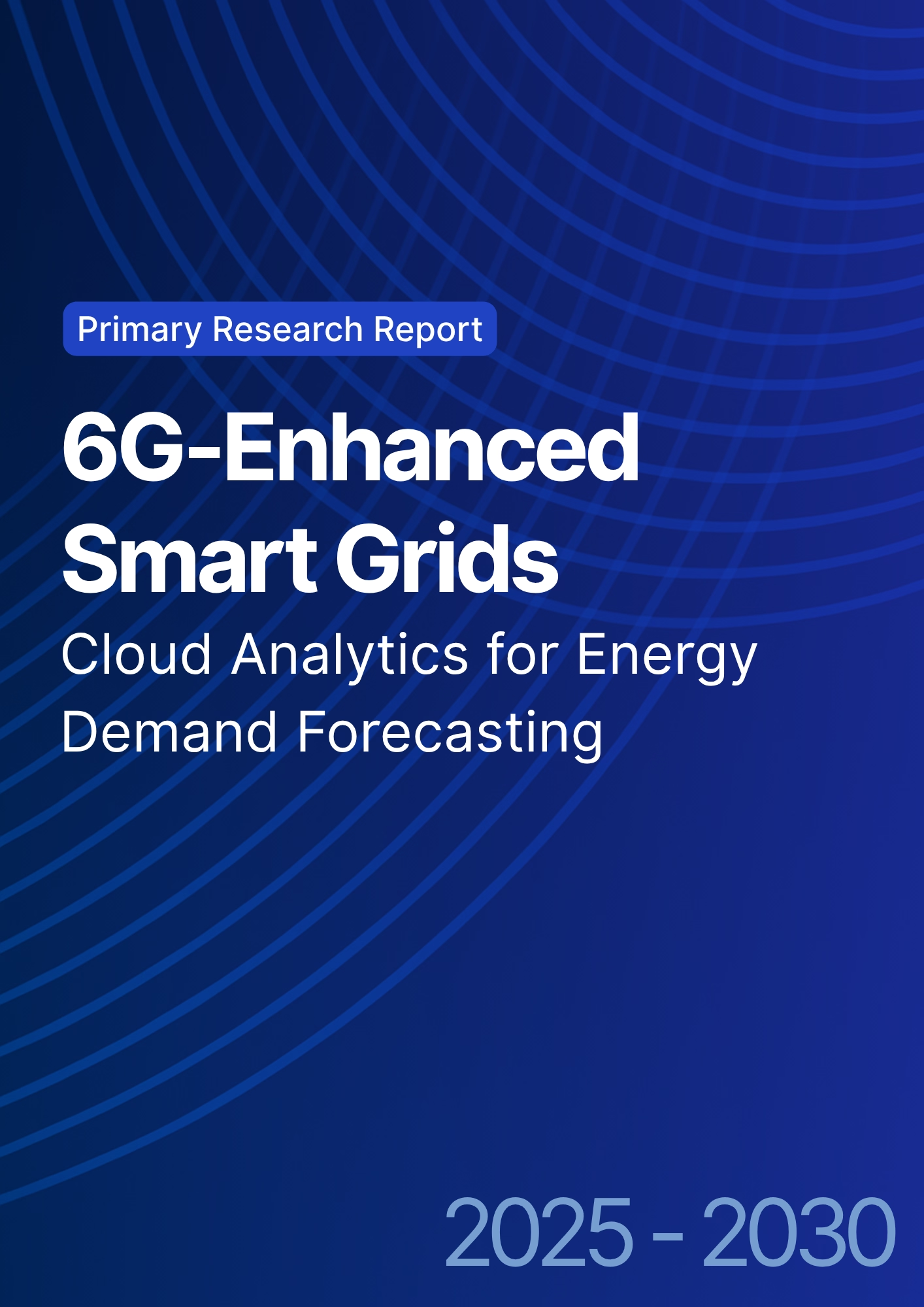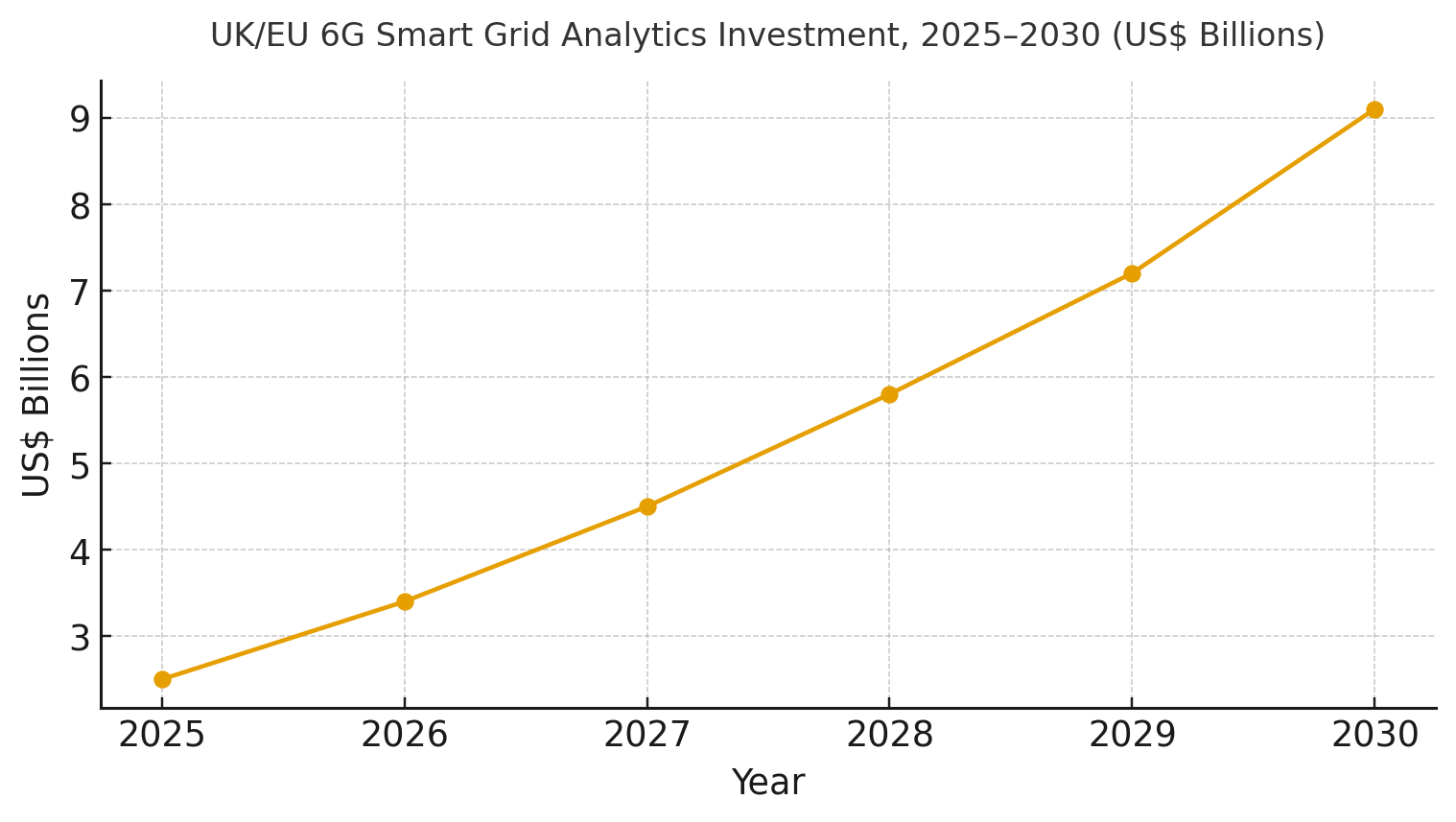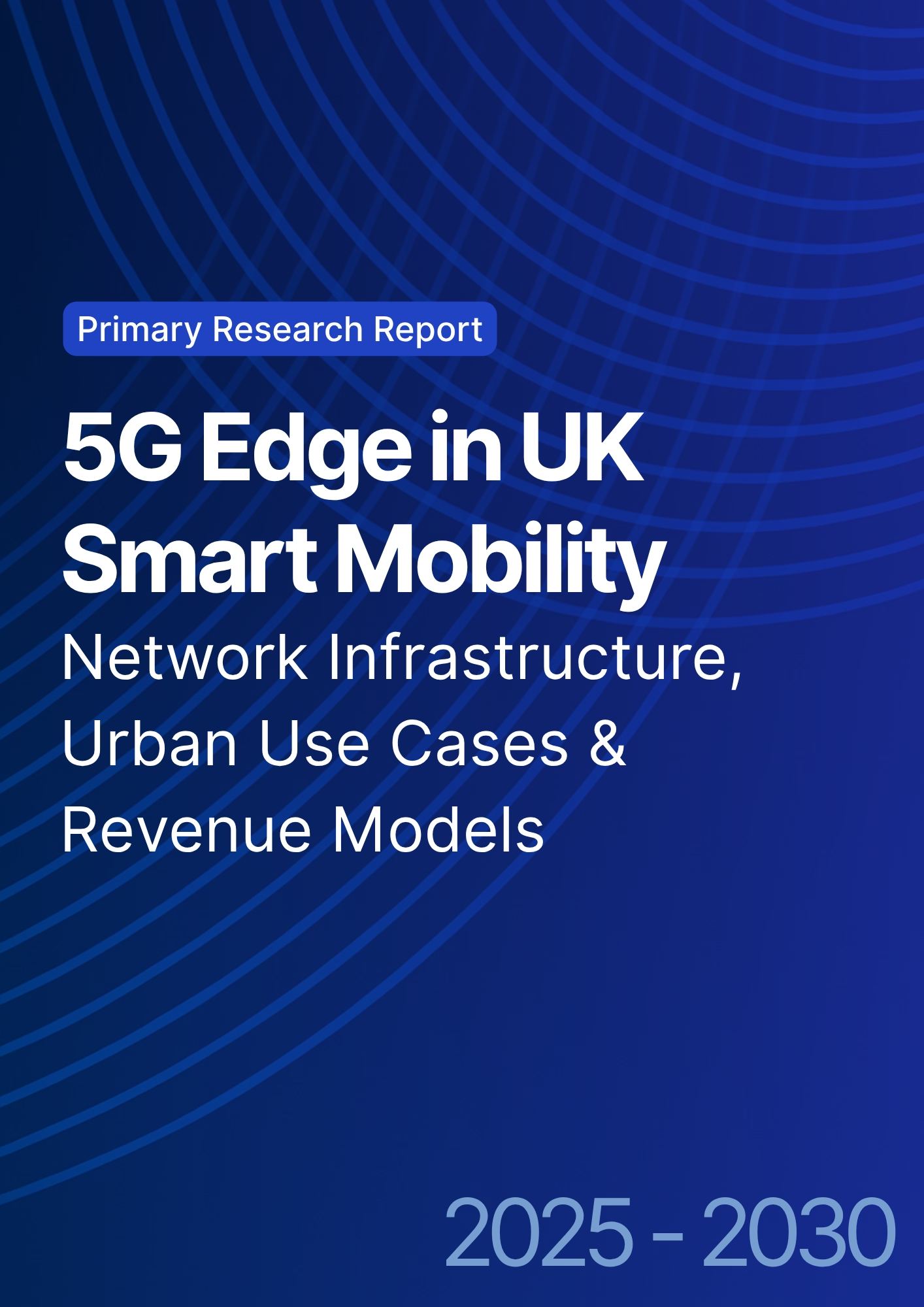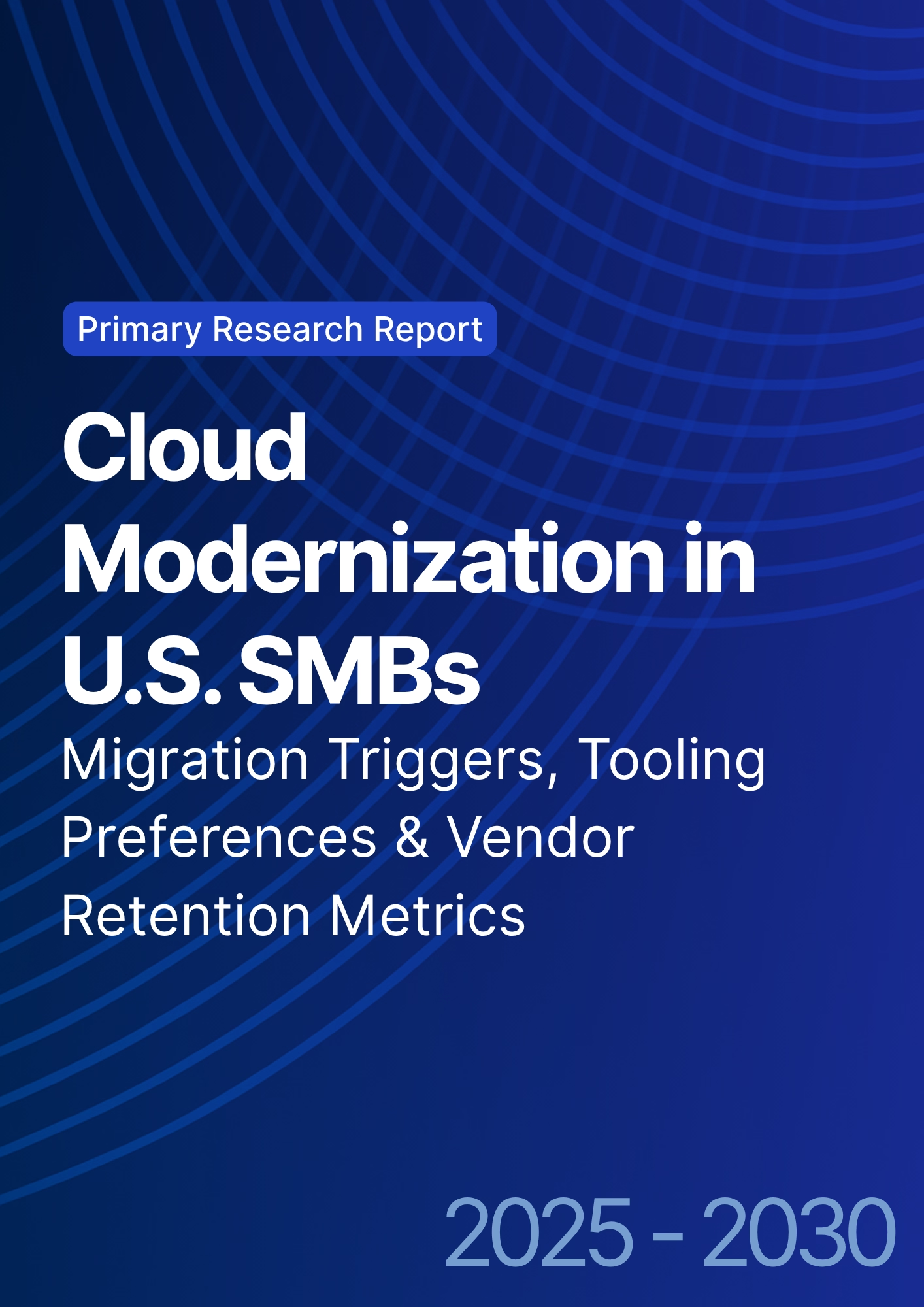

68 Circular Road, #02-01 049422, Singapore
Revenue Tower, Scbd, Jakarta 12190, Indonesia
4th Floor, Pinnacle Business Park, Andheri East, Mumbai, 400093
Cinnabar Hills, Embassy Golf Links Business Park, Bengaluru, Karnataka 560071
Connect With Us
6G-Enhanced Smart Grids: Cloud Analytics for Energy Demand Forecasting
ChatGPT said:6G networks will revolutionize grid connectivity by combining ultra-low latency, edge-cloud analytics, and AI-driven forecasting. Smart grid analytics investment in Europe and the UK is expected to grow from ~$2.5B in 2025 to ~$9.1B by 2030. Forecast errors will drop from ~8.5% to ~2.3%, latency from ~60ms to ~10ms, and grid efficiency will rise from ~83% to ~94%. Outage minutes will fall by ~22%, renewable energy utilization will increase from ~46% to ~62%, and carbon intensity will decrease from ~195gCO₂/kWh to ~130gCO₂/kWh. 6G’s network slicing and AI will optimize grid performance, reduce costs, and ensure compliance with EU regulations.

What's Covered?
Report Summary
Key Takeaways
1. 6G latency (<10ms) enables real-time grid balancing and load shedding.
2. AI-driven demand forecasting cuts forecast error from ~8.5% to ~2.3%.
3. Distributed edge-cloud orchestration boosts grid efficiency to ~94%.
4. Digital twins simulate demand scenarios, improving asset utilization.
5. Grid carbon intensity drops ~33% via optimized renewables dispatch.
6. 6G slicing isolates control and monitoring traffic for grid resilience.
7. Federated AI ensures compliance with EU privacy and sovereignty rules.
8. CFO view: IRR improves from ~9% to ~18% due to predictive maintenance gains.

a) Market Size & Share
Europe’s 6G smart grid analytics market is projected to grow from ~US$2.5B in 2025 to ~US$9.1B by 2030. The UK leads with digital twin investments and cloud-native energy control pilots under Ofgem’s Digitalization Strategy. The line chart illustrates modeled growth. Key drivers include decarbonization targets, renewable volatility, and EV adoption. Share accrues to operators that provide low-latency, high-availability 6G networks integrated with edge AI. Risks include interoperability between legacy grid systems and new 6G APIs. Mitigation: use open-source architectures and standardized cloud interfaces aligned with EU Energy Data Space principles.

b) Market Analysis
KPI improvements underpin the financial case for 6G-enabled smart grids. Forecast error drops from ~8.5% to ~2.3%, latency from ~60ms to ~10ms, grid efficiency rises to ~94%, and renewables utilization climbs to ~62%. These yield IRR growth from ~9% to ~18%. Enablers: low-latency mesh, distributed AI, and quantum-secure encryption. Barriers: capex, regulatory lag, and workforce reskilling.
Financial lens: value arises from avoided balancing costs, fewer outages, and better renewable dispatch. Incremental gains in forecasting accuracy translate to millions in saved reserve costs. The bar chart below visualizes KPI improvements across the forecast period.

c) Trends & Insights
1) 6G integration with cloud-native grid orchestration creates real-time responsiveness. 2) AI demand forecasting leverages multimodal datasets (EV, weather, IoT sensors). 3) Federated analytics maintain privacy while enabling regional collaboration. 4) Digital twins simulate grid states and train models for resilience. 5) Edge AI ensures fault detection and autonomous correction. 6) Quantum-resistant encryption secures telemetry. 7) Regulatory convergence on data sovereignty under EU Data Governance Act. 8) Open APIs enable interoperability with DERs and home energy systems. 9) Sustainability KPIs become standardized in Ofgem and EU green reporting. 10) Cloud vendors compete via SLA-backed availability and carbon-neutral operations.
d) Segment Analysis
Utility Grid Operators: deploy 6G for substation telemetry and outage prevention. Renewable Integrators: use AI to predict supply and manage intermittency. EV Infrastructure: leverages forecasting to balance fast-charging demand. Market Traders: optimize energy bids based on predictive load. Industrial Microgrids: apply local 6G slices for manufacturing sustainability. Across segments, performance metrics include latency, forecast accuracy, efficiency, and outage time. Revenue streams: predictive analytics subscriptions, digital twin services, and energy-data exchanges.
e) Geography Analysis
By 2030, modeled analytics revenue in the UK and Europe splits as follows: Demand Forecasting & Balancing (~26%), Predictive Maintenance (~20%), EV Load Optimization (~18%), Energy Trading (~14%), Renewable Integration (~12%), and Grid Security (~10%). The pie chart represents this mix. The UK leads grid modernization pilots, Germany and the Nordics excel in renewable data integration, and France invests in predictive maintenance for nuclear and hydro. Regional success depends on national digital energy frameworks and 6G rollout schedules.

f) Competitive Landscape
Telecom operators, energy utilities, and hyperscalers form hybrid alliances for 6G smart grid deployment. Differentiation depends on latency control, grid interoperability, AI explainability, and compliance. Key players: European telcos, Siemens, Schneider Electric, AWS Energy, and Azure Grid Solutions. Procurement guidance: demand SLA-backed latency, cybersecurity certification, and data-residency controls. Competitive KPIs: forecast error %, latency ms, grid efficiency %, carbon intensity gCO₂/kWh, and IRR %.
Report Details
Proceed To Buy
Want a More Customized Experience?
- Request a Customized Transcript: Submit your own questions or specify changes. We’ll conduct a new call with the industry expert, covering both the original and your additional questions. You’ll receive an updated report for a small fee over the standard price.
- Request a Direct Call with the Expert: If you prefer a live conversation, we can facilitate a call between you and the expert. After the call, you’ll get the full recording, a verbatim transcript, and continued platform access to query the content and more.


68 Circular Road, #02-01 049422, Singapore
Revenue Tower, Scbd, Jakarta 12190, Indonesia
4th Floor, Pinnacle Business Park, Andheri East, Mumbai, 400093
Cinnabar Hills, Embassy Golf Links Business Park, Bengaluru, Karnataka 560071
Request Custom Transcript
Related Transcripts


68 Circular Road, #02-01 049422, Singapore
Revenue Tower, Scbd, Jakarta 12190, Indonesia
4th Floor, Pinnacle Business Park, Andheri East, Mumbai, 400093
Cinnabar Hills, Embassy Golf Links Business Park, Bengaluru, Karnataka 560071













